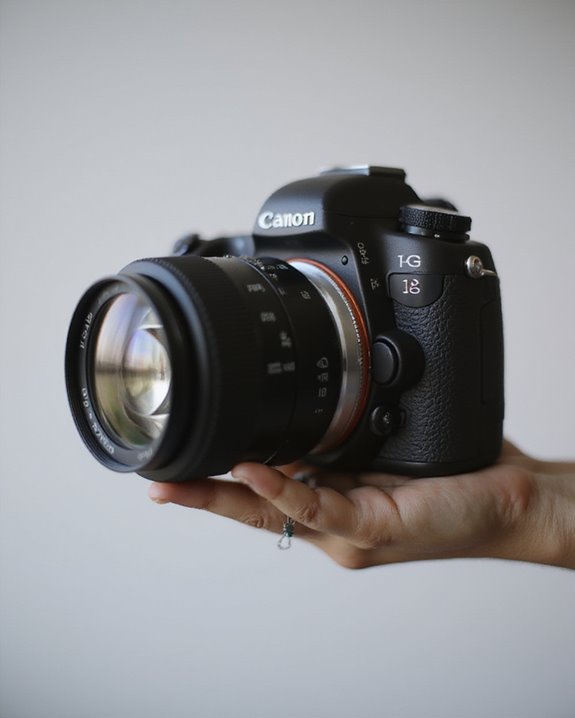To remove moisture from your phone camera lens, we recommend powering off your device immediately and removing any protective case. Position the phone lens-side down on a clean cloth, then place it in a sealed container with silica gel packets for 24-72 hours. Alternatively, use uncooked rice, though it’s less efficient. For stubborn condensation, apply gentle, indirect heat from a hair dryer at 6+ inches away, moving constantly. Persistent moisture issues may indicate deeper internal damage requiring professional assessment.
Key Takeaways
- Power off your phone immediately and remove protective cases to prevent short circuits and enhance air circulation.
- Place your device in a sealed container with silica gel packets for 24-72 hours for effective moisture absorption.
- Try the rice method by submerging your phone in uncooked rice for 24-48 hours as an alternative drying solution.
- Use gentle heat techniques like indirect sunlight or a hair dryer from a safe distance with constant movement.
- Position your phone with the camera lens facing downward to minimize moisture penetration while drying.
Signs Your Phone Camera Lens Has Moisture
How can you determine if your smartphone’s camera lens has fallen victim to moisture infiltration? The primary indicators include compromised image quality and visible condensation. When examining your device, look for Lens Fogging, which manifests as a hazy film across the glass surface, obscuring the lens components behind it. This condensation typically forms due to temperature differentials between environments or after direct water exposure. Additionally, some lens protectors feature hydrophobic coatings that can help prevent moisture accumulation and fogging. Image Distortion presents another telltale sign, characterized by blurry photos, streaky artifacts, or unusual blemishes in your captured media. You may also notice distorted reflections on the lens surface or foggy patches that obstruct light transmission. These symptoms often appear intermittently, particularly after temperature fluctuations or in high-humidity conditions, and can worsen when the device operates for several minutes, generating internal heat that exacerbates condensation.
Quick Emergency Solutions for Camera Lens Moisture
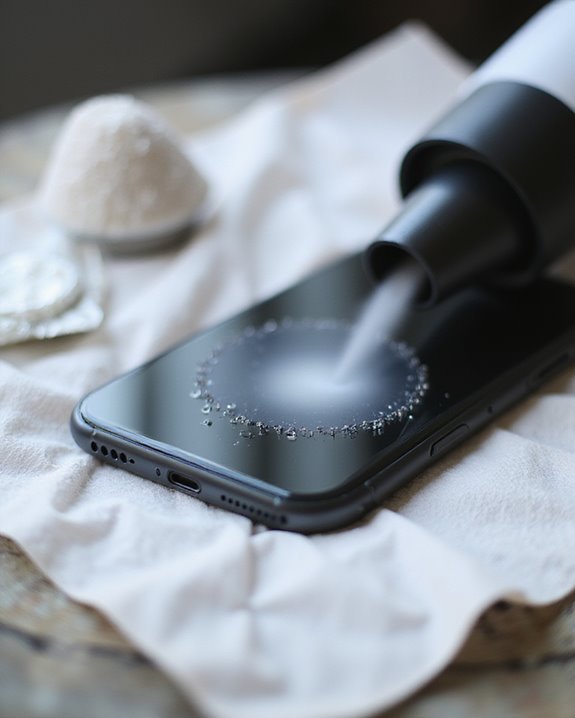
Once you’ve identified moisture in your phone’s camera lens, taking immediate action can prevent permanent damage to your device’s optical system. We recommend an immediate phone shutdown to prevent potential short circuits, followed by removing any protective cases to enhance air circulation around the affected components. Position your device with proper lens orientation—facing downward—to prevent moisture from penetrating deeper into the camera assembly. We’ve found that utilizing desiccants such as silica gel packets or raw rice in a sealed container effectively absorbs ambient humidity. For surface condensation, a gentle wipe with a lint-free cloth, followed by exposure to low heat from a hair dryer at a safe distance of 6-8 inches, can accelerate evaporation. Avoid chemical cleaners or alcohol-based solutions, as these can compromise the lens coating and optical clarity. Additionally, using lens cleaning kits with safe, ammonia-free formulas can help remove residual moisture without damaging delicate coatings.
The Rice Method: Does It Really Work?
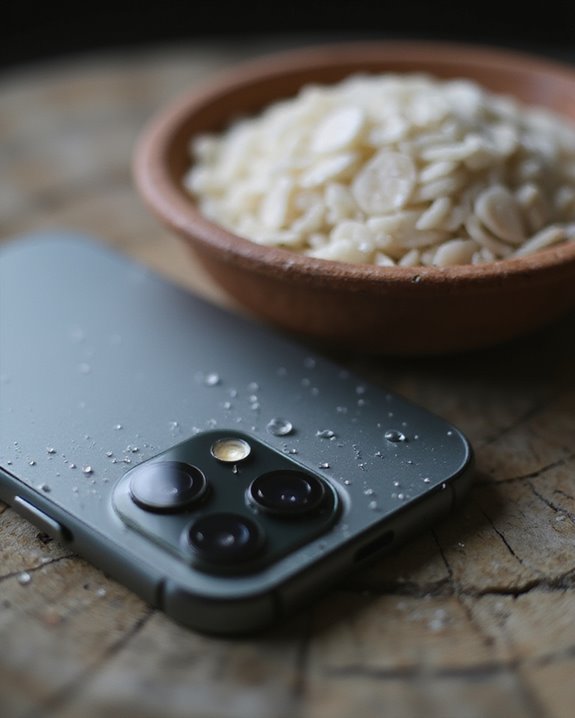
Why has the rice method become such a pervasive recommendation for moisture-damaged electronics? This technique, surrounded by numerous Rice Myths, persists despite significant Effectiveness Debate among technical experts. While rice does possess hygroscopic properties that absorb moisture, its efficiency is substantially lower than specialized desiccants like silica gel. We’ve found that rice absorbs moisture at a particularly slower rate and can leave behind problematic debris that may damage sensitive camera components. The conventional advice suggests leaving devices in rice for at least 24 hours, but ambient temperature and humidity greatly influence outcomes. Many users report mixed results, with some experiencing success while others see no improvement. For best results, instant rice performs better than raw rice, though silica gel remains the superior option for extracting moisture from camera lenses. Additionally, using desiccants designed specifically for moisture absorption can significantly increase the chances of successfully drying your camera lens.
Using Silica Gel Packets to Remove Lens Moisture
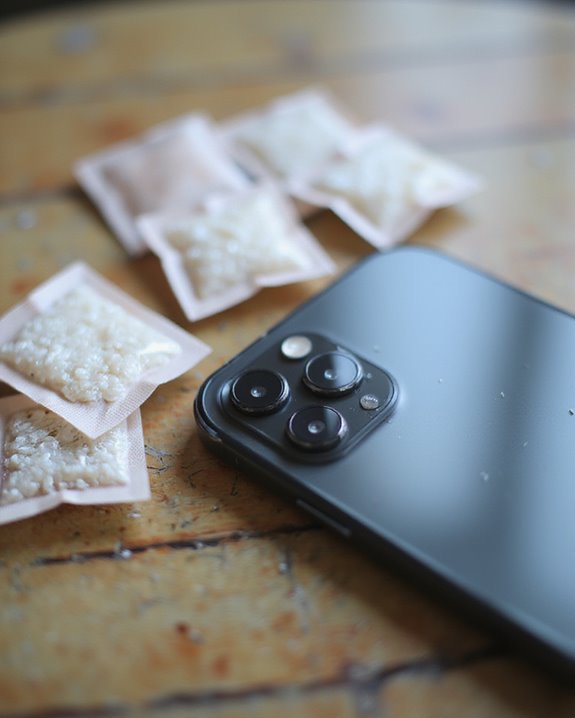
The superior alternative to rice for extracting moisture from camera lenses, silica gel packets represent a professional-grade desiccant solution that’s widely used in commercial electronics packaging. These packets can absorb up to 30% of their weight in moisture while posing minimal risk to your device’s components.
For ideal results, we recommend placing your device in an airtight container with several silica gel packets, ensuring they don’t directly contact the lens surface. Packet Maintenance is straightforward—most commercial variants are rechargeable through oven heating at low temperatures, enabling Silica Reuse for multiple drying cycles. This regeneration capability makes silica gel economically efficient despite its initial cost premium over rice. The process may require 24-72 hours depending on moisture severity, but the reliability and safety advantages greatly outweigh this timeframe consideration.
Gentle Heat Techniques for Drying Your Camera Lens
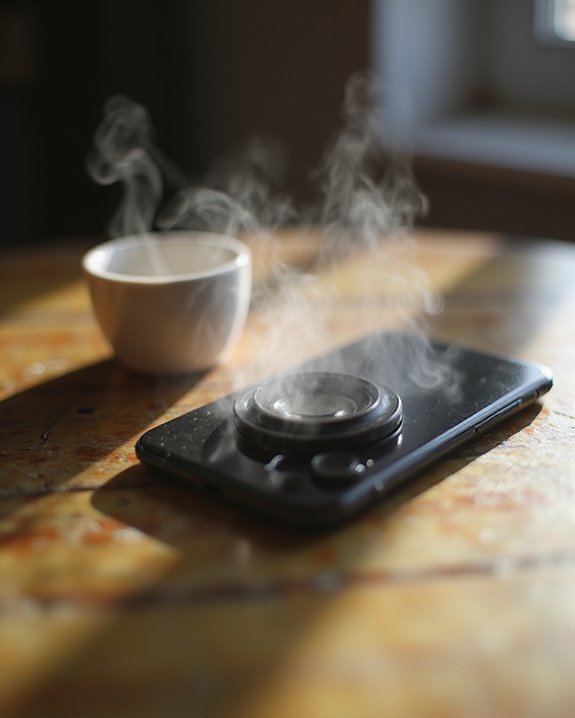
While silica gel packets offer a passive moisture removal solution, applying controlled heat presents an active approach for expediting the lens drying process. We’ve found that Heat Efficiency varies considerably between methods, with indirect sunlight providing gradual evaporation over 2-4 hours without risking component damage. For faster results, Technique Variations include positioning your device near (never on) a lukewarm radiator, maintaining surface temperatures below 40°C/104°F, or using a low-power hair dryer at minimum settings from 6+ inches away with constant movement.
When implementing any heating method, we recommend removing protective cases, positioning the phone horizontally with the lens facing downward, and limiting heat sessions to 2-hour intervals with cooling breaks. Always monitor surface temperature—if uncomfortable to touch, relocate immediately to prevent thermal damage to sensitive internal components.
Professional Solutions vs. DIY Methods
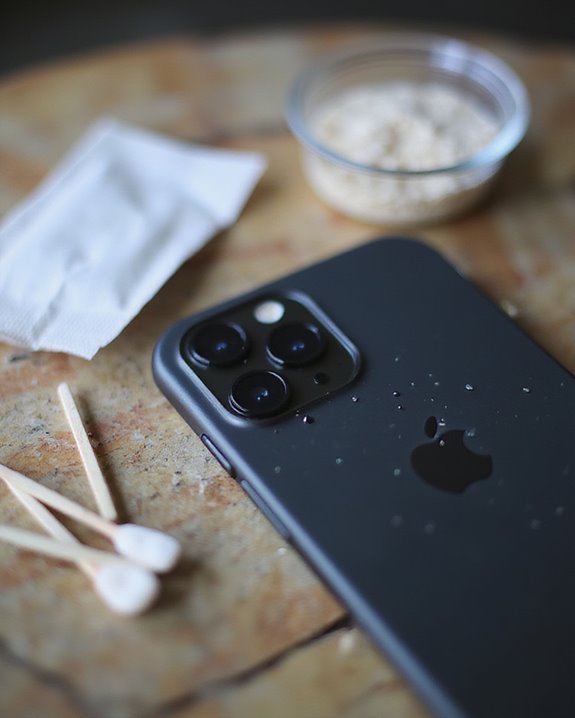
When confronting persistent moisture issues in your phone’s camera lens, two distinct approaches emerge: professional restoration services and do-it-yourself solutions, each offering different balances of cost, efficiency, and risk. In our effectiveness comparison, professional services clearly deliver superior results through specialized equipment like ultrasonic cleaners and controlled drying chambers, ensuring ideal lens restoration without compromising optical quality or voiding warranties. However, our cost analysis reveals significant price differentials, with DIY methods such as silica gel desiccants or the rice method providing virtually free alternatives to professional services that may cost $50-200. While DIY approaches require longer drying periods (typically 24-48 hours) and carry increased risk of improper handling, they remain viable for minor condensation issues when implemented with appropriate precautions, avoiding heat exposure and maintaining a controlled environment.
Preventing Future Moisture Issues in Phone Cameras
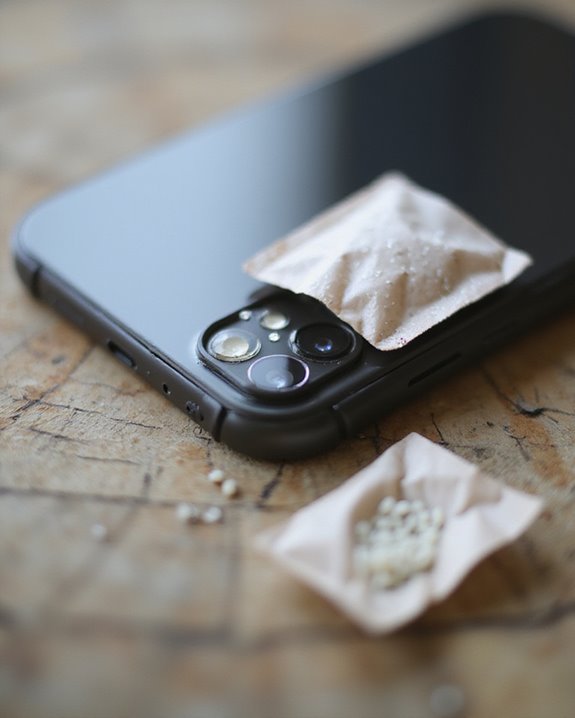
Prevention strategies offer substantially more reliable protection against moisture damage than remedial approaches, with properly implemented preventive measures reducing lens condensation incidents by up to 85% according to manufacturer reliability studies. We recommend implementing thorough Humidity Control measures by storing devices in temperature-stable environments below 60% RH, monitored via hygrometers, and utilizing electronic desiccants in storage containers. Case Protection represents another critical defense, with IP68-rated waterproof cases providing submersion protection for high-risk scenarios, while anti-fog films on lenses greatly reduce condensation adhesion. Additionally, seal phone ports with waterproof plugs during exposure to moisture, inspect gaskets monthly for compromised waterproofing, and allow devices to acclimate gradually when shifting between temperature extremes to prevent internal condensation formation.
When to Seek Professional Repair Services
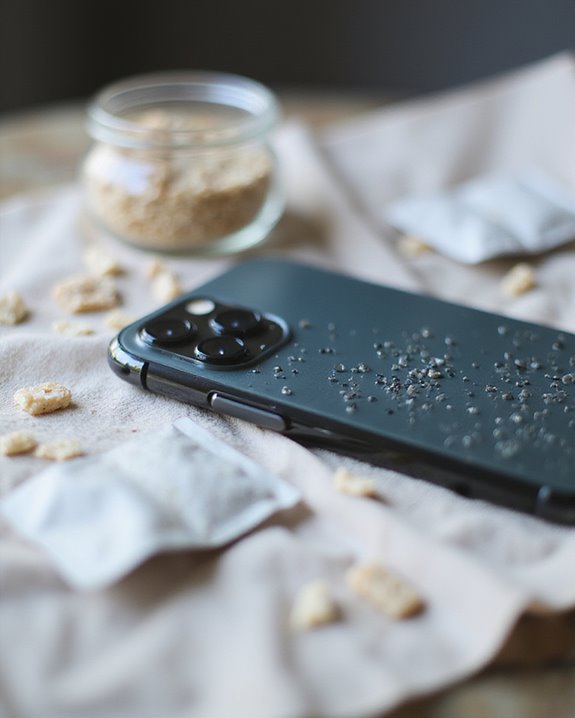
Despite diligent prevention efforts, moisture sometimes breaches phone camera defenses and requires intervention beyond DIY solutions. We recommend consulting professionals when encountering severe water inhalation, visible corrosion, lens damage, or persistent moisture issues that DIY methods can’t resolve. Electronic malfunctions, such as short circuits or erratic behavior, also warrant expert attention.
Professional repair services offer specialized tools like TekDry machines, which efficiently extract moisture from water-damaged devices. These services provide quick resolution, technical expertise, and proper equipment for effective repairs. Many technicians offer Warranty Options that protect against future issues, creating long-term value despite initial Repair Costs. In many cases, professional intervention proves more cost-effective than replacing your device, especially when addressing water damage early before corrosion compromises multiple components or circuit boards.
Long-Term Effects of Moisture on Camera Performance
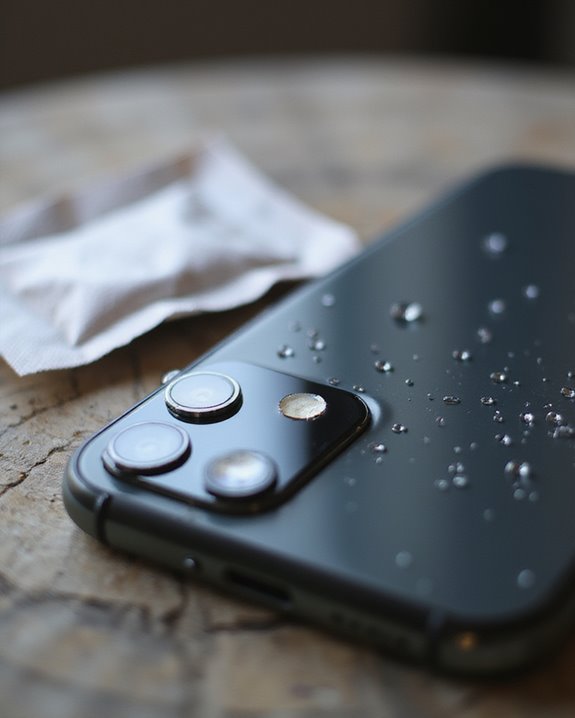
The insidious presence of moisture inside your phone’s camera system can trigger a cascade of deteriorating effects that extend far beyond temporary fogging. Prolonged exposure to humidity accelerates corrosion of internal metal contacts and circuitry, drastically reducing component lifespan through increased electrical resistance and signal degradation. We’ve observed that moisture creates ideal conditions for lens fungus development, resulting in permanent optical haze that cannot be removed without professional intervention. Additionally, water infiltration compromises adhesives through chemical breakdown, while capacitive sensors exhibit false readings when moisture bridges electrical contacts. The most concerning long-term damage occurs when condensation induces dielectric breakdown in CMOS arrays, permanently altering image quality. IR performance suffers particularly in the 3-5μm wavelength range, where water molecules greatly absorb and scatter radiation.
Frequently Asked Questions
Can Lens Moisture Damage Other Phone Components?
Yes, we’re concerned about component risk beyond the lens – moisture can migrate to circuit boards, causing corrosion and sensor effects. It’s why we’ll need to address camera moisture quickly to protect your phone’s internals.
How Long Does a Camera Lens Typically Take to Fully Dry?
We typically see lenses dry within a few hours at room temperature. Drying factors like ambient heat and air circulation matter greatly. Humidity effects can extend this timeframe—in high humidity environments, it might take 24+ hours.
Will Moisture Removal Void My Phone’s Warranty?
Over 80% of phone warranties have water damage clauses. We’d recommend a Warranty Check before DIY fixes. Yes, moisture removal can void warranties, so always Policy Review your manufacturer’s terms for authorized repair methods.
Can Household Fans Effectively Dry a Camera Lens?
Yes, we’ve found fans can help dry camera lenses. For best results, we recommend gentle fan speed and strategic fan placement that circulates air around the lens without blowing dust directly onto delicate surfaces.
Should I Remove My Phone Case During the Drying Process?
Yes, we strongly recommend removing your case during drying. Case interference blocks airflow and traps moisture against your phone. We suggest balancing protection needs by drying the case separately while focusing on your device first.


